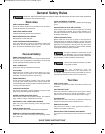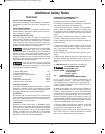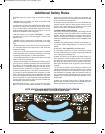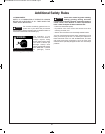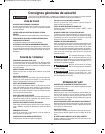
3.
Additional Safety Rules
Tool Care
DO NOT ALTER OR MISUSE TOOL
These tools are precision built. Any alteration or modification
n
ot specified is misuse and may result in dangerous con -
ditions.
AVOID GASEOUS AREAS
Do not operate electric tools in gaseous or explosive at mo -
spheres. Motors in these tools normally spark, and may re -
sult in a dangerous condition.
MAINTAIN TOOLS WITH CARE
Keep tools sharp and clean for better and safer perfor -
mance. Follow instructions for lubricating and changing ac -
cessories. Inspect tool cords periodically and if damaged,
have repaired by authorized service facility. Inspect ex -
tension cords periodically and replace if damaged. Keep
handles dry, clean and free from oil and grease.
Before connecting the tool to a power source
(receptacle, outlet, etc.), be sure voltage
supplied is the same as that specified on the nameplate of
the tool. A power source with voltage greater than that
specified for the tool can result in serious injury to the user —
as well as damage to the tool. If in doubt, DO NOT PLUG IN
THE TOOL. Using a power source with voltage less than the
nameplate rating is harmful to the motor.
For your own safety, do not operate your
table saw until it is completely assembled
and installed according to the instructions … and until you
have read and understood the following:
1. General Safety Rules. . . . . . . . . . . . . . . . . . 2–5
2. Double Insulated Tools . . . . . . . . . . . . . . . . . . 5
3. Getting To Know Your Table Saw. . . . . . . . . . 24, 26
4. Adjustments. . . . . . . . . . . . . . . . . . . . . . . . . . . . . . . . 30–38
5. Assembly. . . . . . . . . . . . . . . . . . . . . . . 40–46
6. Basic Table Saw Operation . . . . . . . . . . . . . 48–72
7. Maintaining Your Table Saw. . . . . . . . . . . . . 72–74
8. STABILITY OF SAW
Your table saw MUST BE BOLTED securely to a stand or
workbench. In addition, if there is any tendency for the table
saw to tip over or move during certain operations such as
cutting long, heavy boards, use an auxiliary support.
9. LOCATION
Use the table saw in a well lit area and on a level surface,
clean and smooth enough to reduce the risk of trips and falls.
Use it where neither the operator nor the casual observer is
forced to stand in line with the blade.
10. KICKBACK
Kickbacks can cause serious injury: A “KICKBACK” occurs
when a part of the workpiece binds between the sawblade
and the rip fence or other fixed object. Workpiece binding the
blade due to misalignment, can also cause kickback. During
kickback, workpiece rises from table and is thrown toward
the operator. Keep your face and body to one side of the
sawblade, out of line with a possible “KICKBACK”.
KICKBACKS AND POSSIBLE INJURY
CAN USUALLY BE AVOIDED BY:
a. Maintaining the rip fence parallel to the sawblade.
b. Keeping the sawblade sharp. Replacing or sharpening
anti-kickback pawls when points become dull.
c. Keeping sawblade guard, spreader and anti-kickback
pawls in place and operating properly. The spreader must
b
e in alignment with the sawblade and the pawls must stop
a kickback once it has started. Check their action before
ripping.
d. NOT ripping workpiece that is twisted or warped or does
not have a straight edge to guide along the rip fence.
e. NOT releasing work until you have pushed it all the way
past the sawblade.
f. Using a Push Stick for ripping widths of 2" to 6" and an
auxiliary fence and Push Block for ripping widths narrower
than 2" (See “Basic Saw Operation, Using The Rip Fence”
section, pages 60, 62).
g. NOT confining the cut-off piece when ripping or cross -
cutting.
h. When ripping, apply the feed force to the section of the
workpiece between the sawblade and the rip fence. Use
Push Stick or Push Block when appropriate (See item f.
above).
11. PROTECTION: Eyes, hands, face, ears and body.
TO AVOID BEING PULLED INTO
THE SPINNING TOOL,
DO NOT WEAR: Loose Fitting Gloves
Loose Clothing
Necktie, Jewelry
DO: TIE BACK LONG HAIR
ROLL LONG SLEEVES ABOVE ELBOWS
a. If any part of your saw is missing, malfunctioning, has
been damaged or broken … such as the motor switch, or
other operating control, a safety device or the power cord …
cease operating immediately until the particular part is
properly repaired or replaced.
b. Wear safety goggles and a face shield if operation is
dusty. Wear ear plugs or muffs during extended periods of
operation. Small loose pieces of wood or other objects that
contact the rear of the revolving blade can be thrown back
at the operator at excessive speed. This can usually be
avoided by keeping the guard and spreader in place for all
“THRU-SAWING” operations (sawing entirely thru the work)
AND by removing all loose pieces from the table with a long
stick of wood IMMEDIATELY after they are cut off.
c. Use extra caution when the guard assembly is removed
for resawing, dadoing, rabbeting or molding — replace the
guard as soon as that operation is completed.
d. NEVER turn the saw “ON” before clearing the table of all
tools, wood scraps, etc., except the workpiece and related
feed or support devices for the operation planned.
WARNING
!
WARNING
!
WARNING
!
SM 2610008289 02-10:3310 Table Saw 2/2/10 8:38 AM Page 3




